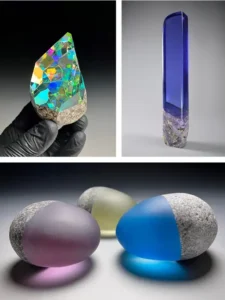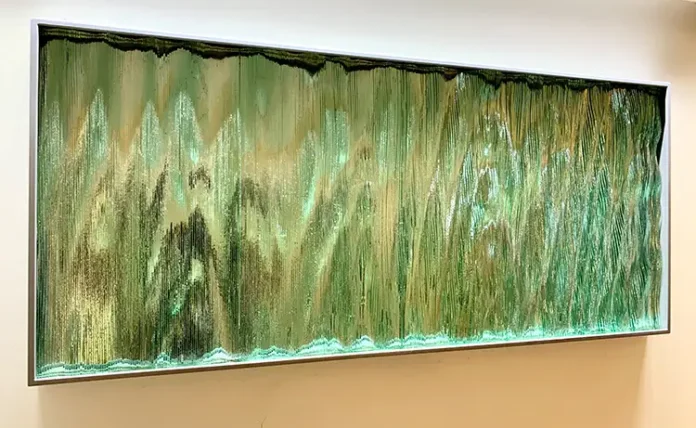By Liz Stevens, writer, UV+EB Technology
UV curing and UV-curable adhesives are used in a variety of products and applications, many of which are commonplace, such as food packaging, laminated flooring and pickleball paddles. Others are not quite so ubiquitous, like Fender Musical Instruments Corporation’s use of UV curing on the base coat of its legendary guitars. 1 In addition to helping to make stellar musical instruments, UV is used to help make standout art. UV-curable adhesives, it turns out, really deliver when it comes to stunning aesthetics and an unbeatable bond.
Weston Lambert is a Tacoma, Washington-based artist and sculptor. Lambert is an expert in creating art with glass and with stone, and some of his most beautiful pieces are glass/stone combinations. UV-curable adhesives make a rock-solid bond between glass and glass, and also between glass and stone. The UV-curable adhesives that Lambert uses have low viscosity and rapid tacking – characteristics that are especially helpful in Lambert’s sculpting process.
One of Lambert’s glass-to-glass creations that benefited from those qualities is his commissioned installation, “Currents,” which is on permanent display in the Interfaith Prayer and Meditation Room at the Seattle-Tacoma International Airport. The 7’5″ x 3’3″ piece weighs 1,000 pounds and is composed of 400 slices of individually cut 1/4-inch sheet glass. Each slice of sheet glass was hand cut with a waved edge, then the pieces were turned on edge and glued together to form a three-dimensional undulating pattern. “I used UV-curable adhesive to join the four panels that make up the piece,” said Lambert. “Each panel has a line of UV-curable glue going through it, and I used a ballistic adhesive to glue the wave pieces to the mirror behind it all. This piece has a combination of different adhesives, but primarily UV-curable adhesive.”
Lambert uses epoxies, silicones and UV-curable adhesives. “I would say that UV-curable adhesive’s best trait also is its worst trait – it doesn’t fill gaps,” Lambert said. “The low-viscosity aspect is wonderful when you need to fill a tiny crack or for a perfectly seamless join for two pieces of sheet glass. But when the fit between two pieces is not perfect, UV-curable adhesive just flows through the gap. And it doesn’t cure unless it is in an anaerobic environment.” Lambert appreciates the adhesive’s rapid tacking ability. “It is really nice for something that needs to tack immediately and stay in place,” he explained. “When I have complex forms to assemble, as long as I have them jigged up properly, I can put the adhesive on, join the pieces and then continue working on the artwork almost immediately. I don’t have to wait. My epoxy adhesive, on the other hand, takes seven days to cure.”
Rapid tacking and almost immediate curing were essential for the Sea-Tac Airport artwork. “Using UV-curable adhesive was great because it can tack really quickly,” Lambert said. “I could position a slice of glass, apply a line of adhesive that would wick down beneath the slice, expose that briefly with UV to tack it, and then immediately add the next piece of glass. Each time I did a tack exposure, the previous layer of glued glass got cured a little bit more. That meant that I could work fairly rapidly.”
Lambert uses Bohle Verifix UV-curable adhesive because it has ultra-low viscosity and high wicking ability. When asked what sort of UV lamps Lambert uses, his reply was surprising. “Honestly, my favorite is the sun,” he said. If it is a cloudy day in the Pacific Northwest, Lambert uses UV flashlights on small art pieces. For larger artworks, he will borrow UV lamps or fabricate the artwork at a shop that is equipped with UV lamps.
 Lambert creates glass-to-stone sculptures that feature a stack of laminated sheet glass joined to a beautiful chunk of stone or mineral, all of which are meticulously shaped into a graceful form. Lambert uses a workshop full of cutting, grinding and polishing tools to sculpt artworks that are half-glass, with enhanced refraction due to the sheet glass layers, and half stone, such as basalt or labradorite.
Lambert creates glass-to-stone sculptures that feature a stack of laminated sheet glass joined to a beautiful chunk of stone or mineral, all of which are meticulously shaped into a graceful form. Lambert uses a workshop full of cutting, grinding and polishing tools to sculpt artworks that are half-glass, with enhanced refraction due to the sheet glass layers, and half stone, such as basalt or labradorite.
“One of the drawbacks with UV-curable glue is that the more aggressive or brutal the art fabrication process is, the less well the adhesive responds,” Lambert explained. “If I am carving with a really aggressive style, it doesn’t react well because it is not as flexible as epoxy. If I grind really hard on the belt sander, which will produce more heat, UV-curable adhesive is more likely to delaminate.” Lambert chooses the adhesive for a piece of artwork based on the nature of the materials and the characteristics of the adhesives. “I am not describing UV-curables from a tech sheet specs perspective; I’m talking from a hands-on experiential viewpoint. I beat the crap out of all of my substrates and adhesive materials so that I know the parameters, and, in my experience, UV-curable adhesive is more sensitive to heat and vibration than, for example, an epoxy.”
With his artistic skill, sculpting expertise and knowledge of UV-curable adhesive’s strengths and weaknesses, Lambert is enjoying great success with his work. He has 250,000 followers on Instagram, half a million fans on TikTok, and a perpetually “sold out” inventory of beautiful artworks. For a short video on the glass lamination process used to create Lambert’s “Currents” piece, visit www.instagram.com/p/Ct28uedLmdW/. For more information, visit www.westonlambert.com.







